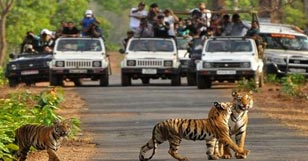About Rajaji National Park
Rajaji National Park, nestled in the heart of Uttarakhand, is a sanctuary teeming with diverse wildlife, notably renowned for its wild elephant population and rich variety of flora. Named after the esteemed freedom fighter C. Rajagopalachari, it sprawls across 820.42 square kilometres. In 2015, an additional 255.63 sq. km. of adjacent reserve forest was annexed to form a buffer zone, expanding the park's area to a total of 1075 sq. km. and establishing it as the Rajaji Tiger Reserve under the Wild Life Protection Act of 1972. This reserve not only provides pristine aura but also acts as a vital lung for Uttarakhand's major cities - the capital city Dehradun, the sacred city Haridwar, and the yoga hub Rishikesh.
The Rajaji Tiger Reserve boasts a diverse array of forest types, including semi-evergreen, deciduous, mixed broad-leaved, and Terai grassland, categorised as the Indus-Ganges Monsoon Forest type. The majestic Sal trees (Shorea Robusta) dominate much of the landscape within the reserve. Notably, the reserve harbours a significant population of Tigers and Asian Elephants. Among its diverse wildlife inhabitants are leopards, Jungle cats, Himalayan Black Bears, Sloth Bears, Striped Hyenas, Goral, Sambar, Wild Pigs, Spotted Deer, and Barking Deer. Moreover, the reserve serves as a haven for avian species, including Vultures, Woodpeckers, Hornbills, and various migratory birds such as Ruddy Shelducks, Larger Cormorants, Red Crested Pochards, and Mallard Ducks. Additionally, the aquatic habitats supported by rivers and streams within the reserve host around 42 species of fish. Furthermore, the reserve provides a habitat for a diverse range of reptiles, including the King Cobra, Burmese Python, and Common Krait.









